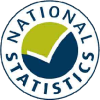Higher Education Student Statistics: UK, 2018/19 - Student numbers and characteristics
- Summary
- Student numbers and characteristics
- Where students come from and go to study
- Subjects studied
- Qualifications achieved
- Notes
How many students are in HE?
Figure 3 shows:
- The total number of HE students stood at 2,383,970 in 2018/19, an increase of 2% from 2017/18.
- Masters taught courses attracted an increasing number of first year students beginning in 2016/17. This initially coincided with the introduction of postgraduate loans for masters' students, but in 2017/18 and 2018/19 was mostly due to an increase in non-EU students.
- Other undergraduate first year student numbers have continually declined over the period 2014/15 - 2018/19. This is apparent at all levels of other undergraduate study except foundation degrees.
- Overall, part-time student numbers have increased this year, first year enrolments onto part-time first degree courses have been increasing since 2016/17. Around half of this increase is attributed to an increased uptake in apprenticeships.
First degrees generally lead to a bachelors qualification such as BA or BSc (rather than a masters or doctorate degree). ‘First degree’ describes the course of study and may include students who already hold a first degree. See the level of study definitions for more detail.
Figure 3 - HE student enrolments by level of study
Academic years 2014/15 to 2018/19
Show:
Reset filters | Download table (csv) | Download source data (csv) | About SB255 Figure 3 | Notes
This option restricts the table to only show students who were on the first year of their course. This is useful for restricting data to the newest cohort of entrants. See the year of study definitions for more detail.
How many students are at APs?
The total number of HE students on designated courses at APs in the 2018/19 record stood at 71,390. There were a further 1,875 students on non-designated courses. From 2017/18 all providers were required for the first time to return postgraduates on both taught and research courses (see notes for further details). As a result, care should be taken when making comparisons over time. Some variances in year on year numbers are a result of changes in coverage of the data collected, rather than a true reflection of the total number of students at APs. However, it is worth noting that the number of APs submitting to HESA can vary each year due to the status of their designation (see mergers and name changes for more information).
Figure 3a shows:
- The number of undergraduate students on designated courses at APs fell to 55,010 in 2018/19, a decrease of 2% from 2017/18.
- On designated HNC/HND courses, overall student enrolments saw a decrease of 22% from 2017/18 to 2018/19. First year enrolments saw a decrease of 31% for the same period.
- Designated masters taught courses rose 12% from 2017/18 to 2018/19.
Figure 3a - Alternative provider student enrolments by level of study
Academic years 2015/16 to 2018/19
Show:
Reset filters | Download table (csv) | Download source data (csv) | About SB255 Figure 3a | Notes
Figure 3b shows:
- From 2017/18 to 2018/19 there has been an increase of 9% for enrolments on designated postgraduate courses at APs. For publicly funded HE providers, this increase is 3%.
- Other undergraduate course enrolments in all provider types has fallen over the five year period. For designated courses at APs this decrease is 8,290, or 32%. Publicly funded HE providers enrolments have decreased by 59,520, or 29% for the same period.
- Similarly, from 2017/18 to 2018/19 other undergraduate course enrolments at APs fell by 3,280 or 16%, publicly funded HE providers saw a 9,295 or 6% decline.
- AP designated first degree course enrolments in 2014/15 were at 23,920. This increased by 56% to 37,380 in 2018/19. For the same period, first degree courses at publicly funded HE providers increased by 128,250 or 8%.
Figure 3b - HE student enrolments at HE, FE and designated courses at alternative providers by level of study and HE provider type
Academic years 2014/15 to 2018/19
Reset filters | Download table (csv) | Download source data (csv) | About SB255 Figure 3b | Notes
Further education (FE) providers are typically FE Colleges or Sixth form colleges. They mainly provide further education courses (see What qualification levels mean on gov.uk) to students aged 16 and over, that are not at the higher education (HE) level. FE providers are generally funded by a different mechanism from HE providers and their data collected by different organisations.
Many FE providers also provide some HE level courses. The FE funding and data collection bodies have provided aggregate statistics about students on HE courses so that we can give an overview of the full scale of higher education study in the UK.
What are the characteristics of HE students?
Sex of students
- Of all HE students 57% were female in 2018/19 (see Figure 4), this has been the same since 2016/17.
- A larger proportion of part-time students were female than full-time students.
- For other undergraduate students, 64% were female, compared with 49% of postgraduate (research) students.
Age of students
- The overall number of first year students aged 30 and over has increased in 2018/19 after a decreasing trend in previous years.
- The number of first year students aged 21-24 has increased from 2015/16 to 2018/19.
- The number of first year full-time students aged 30 and over has increased every year since 2014/15.
- Numbers of full-time students aged 20 and under have increased year on year since 2012/13.
Student disability status
- The overall number of students with a known disability is increasing year on year. The main reason for this increase is students identified as having a mental health condition.
- Of students with a known disability in 2018/19 the category of specific learning difficulty is the largest group accounting for 36% of the total.
Ethnicity of students
- The percentage of UK domiciled students that are White has decreased over the last five years. However, the percentage that are Asian, Mixed and from Other ethnic backgrounds has increased.
- HE providers in England show the largest decrease and the lowest proportion of UK domiciled students that are White compared to HE providers in all other countries of the UK.
Figure 4 - HE student enrolments by personal characteristics
Academic years 2014/15 to 2018/19
Show:
Reset filters | Download table (csv) | Download source data (csv) | About SB255 Figure 4 | Notes
UK domiciled means that the UK was a student’s normal place of residence before starting their course. In this release Guernsey, Jersey and Isle of Man residents are included in ‘UK domiciled’. See the domicile definitions for more detail.
Sex of students at APs
- Of all HE students on designated courses at APs, 56% were female in 2018/19 (see Figure 4a).
- A larger proportion of part-time students were female than full-time students.
- Of all postgraduate students, 62% were female, compared with 54% of all undergraduate students.
Age of students at APs
- Among undergraduate students on designated courses in 2018/19, 40% were aged 30 and over. In comparison, just 26% of postgraduate students were aged 30 and over. Data on publicly funded HE providers shows 13% of undergraduates and 39% of postgraduates were aged 30 and over in 2018/19.
- There was a year on year decline in the percentage of part-time undergraduate students aged 30 and over between 2015/16 and 2018/19. Conversely, the share of students under 20 rose over the four year period.
Student disability status at APs
- Students with a known disability have increased in number from 2015/16 to 2018/19. The proportion of students with a known disability against those with no known disability has also increased. The categories containing the highest number of students with a known disability in 2018/19 are: a specific learning difficulty such as dyslexia, dyspraxia or AD(H)D, and, a mental health condition, such as depression, schizophrenia or anxiety disorder.
Ethnicity of students at APs
- Of full-time UK domiciled students on designated courses at APs, 53% were White in 2018/19. In comparison, 72% of part-time UK domiciled students on designated courses were White. Data on publicly funded HE providers shows 74% of full-time and 82% of part-time UK domiciled students were White in 2018/19.
- Black students accounted for 25% of all enrolments amongst UK domiciled undergraduate students at APs in 2018/19. Asian students made up 12% of enrolments.
- A notably higher percentage of full-time undergraduate students were Black and Minority Ethnic (BME) (48%) than full-time postgraduate students (37%).
The HESA student record includes ethnicity information collected from HE providers (see ethnicity definition).
BME stands for ‘Black and minority ethnic’ and is a combination of the Black, Asian, Mixed and Other ethnicity categories.
Figure 4a - Alternative provider student enrolments on designated courses by personal characteristics
Academic years 2015/16 to 2018/19
Show:
Reset filters | Download table (csv) | Download source data (csv) | About SB255 Figure 4a | Notes
Widening participation data is only returned to HESA for students who apply through UCAS, so to align with the cohort who typically enter through this route, Figure 5 has been restricted to undergraduate UK domiciled full-time students.
Index of multiple deprivation (IMD) applies to student domicile, other domicile IMD data will be hidden when a country is selected. This year, the data is shown in quintiles for all countries for the first time. The various indices of multiple deprivation use similar methodologies, but differ in the indicators used, the time periods included and the sizes of the areas they cover. These factors mean that IMD is not comparable.
Low participation neighbourhood information comes from the participation of local areas (POLAR) classification, which is maintained by the Office for Students. This data shows:
- Other undergraduate students from state-funded schools or colleges account for a higher proportion against privately funded school than students studying a first degree.
- First degree students with one or more parents that have attained a higher education qualification account for 50% of the total number. For other undergraduate students, this is 36%.
- A higher proportion of other undergraduate students were from a low participation neighbourhood than first degree students across the five year time series.
Figure 5 - UK domiciled full-time HE undergraduate student enrolments by participation characteristics
Academic years 2014/15 to 2018/19
Show:
Reset filters | Download table (csv) | Download source data (csv) | About SB255 Figure 5 | Notes
Please note, figure 5a applies to UK domiciled full-time students enrolled on designated undergraduate courses at APs. This change in population is unique to figure 5a.
- There has been a 20% decline from 2017/18 to 2018/19 in designated first year course enrolments from state-funded schools or colleges. Note, however that there is a relatively high number of students in the category Unknown or not applicable school type which will affect this proportion.
Figure 5a - UK domiciled full-time undergraduate alternative provider student enrolments on designated courses by participation characteristics
Academic years 2015/16 to 2018/19
Show:
Reset filters | Download table (csv) | Download source data (csv) | About SB255 Figure 5a | Notes

Release date
16 January 2020, 9:30
29 January 2020, 9:30
Coverage
UK
Release frequency
Annual - view all releases (1998/99 onwards)
Themes
Children, education and skills
Issued by
HESA, 95 Promenade, Cheltenham, GL50 1HZ
Press enquiries
+44 (0) 1242 211 120, [email protected]
Public enquiries
+44 (0) 1242 211 494, [email protected]
Statistician
Rebecca Mantle
Pre-release access
Pre-release access list for 16 January 2020 release
Pre-release access list for 29 January 2020 supplement





